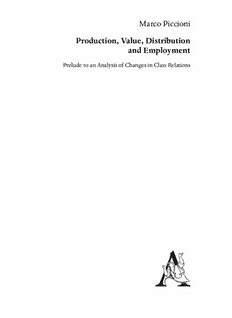
Production, value, distribution and employment PDF
Preview Production, value, distribution and employment
Marco Piccioni Production, Value, Distribution and Employment PreludetoanAnalysisofChangesinClassRelations Copyright©MMXIV ARACNEeditriceint.leS.r.l. www.aracneeditrice.it [email protected] viaRaffaeleGarofalo,/A–B Roma () ---- Nopartofthisbookmaybereproduced byprint,photoprint,microfilm,microfiche,oranyothermeans, withoutpublisher’sauthorization. Ithedition:December NichtdenZeitgenossen,nichtdenLandsgenossen... ArthurSchopenhauer Contents Preface ChapterI Therealproblemis... .Centralfeatureofthesurplusapproach,–.Interdependenciesand basicquestions,. ChapterII Themarginalisttreatmentof“collectiveactions” .Introduction:whyandhowdo“collectiveactions”comeabout?, –.Problem:“free”individualchoicesvsmarginalistnotionof“free competition”,–.Marginalistlineofreasoning;Böhm–Bawerkand Marshall’s thesis on dissolution of “combinations”, – . Universal coalitionsassumed,–.FirststageofBöhm–Bawerk’sanalysis;all possiblealternatives;w–rcurve,–.Entrepreneursandcapitalists, – . Mobility of capital and labour (see Ch. IV), – . Notional possibilitiesvsrealpossibilities,–.“Free–competition”equilibrium asrealpossibility,–.SecondstageofBöhm–Bawerk’sanalysis;em- ployers’ reaction to increased wage; a particular assumption (see Ch. III),–.Changeinthe“cheapestcombinationoffactors”(seeCh.III); effectonemployment,–.ThirdstageofBöhm–Bawerk’sanalysis; unemploymentandunderbidding:anotherparticularassumption(see Ch.III);arequirementforvalidity(seeCh.III),–.Böhm–Bawerk’s generalconclusion:theoremisdemonstrated;ananswertotheprob- lemof§ii:temporaryvslong–runindividualchoices,–.How Böhm-Bawerk explains persistent “combinations”, – . Marshall on persistent “combinations”; the “fear of spoiling the market”, – .MarshallandSmithoncompetition(seeCh.IV),. ChapterIII Someissuesoncollectiveactions . Difficulty as to a requirement for validity (see § II.): in general, “demandforlabour”maybeinelastic,–.Meaningandimplication Contents ofdifficulty,–.Marshallonelasticityof“demandforlabour”and hoursoflabour,–.Marshallonwagesandexportationofcapital, –.Summingupandfollowingpoints;threeelementsprovidingthe groundsforthemarginalistgeneralmethodofconstructingparticular analyses(see§§II.–),–.Firstelement:relationbetweenrateof profitsand“capital”/labourratio:acritique,–.Animplicationof thecritique:“counteractingforces”tendingtodissolveany“combina- tion”notalwayspossible,–.Furtherimplicationofthecritique: cases in which persistent “combinations” are even necessary; second element(indefiniteunderbiddingbyunemployedworkers)shownil- logical;marginalistclaim(see§II.xiii)contradicted,–.Remarks onunemployedworkers’behaviour;whythe“free”individualmayar- riveto,andpersistin,choosingacourseofactionquitedifferentfrom underbidding, – . “Freedom” and rules, – . Critique of third element:employers’“free”reactiontoenforcedwage;anexampleof capitalists’behaviourcontradictingthemarginalistassumption;insti- tutionsandmethodsofproduction,–.Workers’collectiveaction influencingmethodsofproduction,–.Acomprehensiveassess- mentofthemarginalistanalysis:“labourdemandcurve”dissolved;“free competition”ascontradictioninterms,–.Edgeworthon“com- binations”and“artofbargaining”,–.Stigleroncompetitionand social/juridicalnorms,. ChapterIV From“combinations”tosocialclasses:changesinclassrelations andchangesindistributionandemployment . Particular “combinations” and class “combinations” in Smith, – . Mobility of capital, land, and labour; why it may induce solidarity withinaclass“combination”,–.Whytheabovemobilityisnota “natural”outcomeof“liberty”,–.Smithian“competition”,class relations,andtheinstitutionalarrangementsofsociety,–.Awide range of phenomena should be taken into account, – . How to organizetheirtreatment;ahintfromEngels;whynecessary,univocal, irreversible“laws”areexcluded,–.Thesurplusapproachtreatment ofchangesinclassrelations,distribution,andemployment;therangeof realpossibilities;plausiblescenarios,. References Preface Thisworkistobeconsideredasatentativefirststepintoavastand complexfieldofresearch—“persassiacuti,edaltarena”.Theauthor willtrytodevelopinthefuturetheremarkspresentedhere. IamindebtedtoAntoniaCampusforconstantencouragementand manystimulatingconversations. MP UniversitàdiNapoli“FedericoII” DipartimentodiEconomia,Management,Istituzioni ChapterI The real problem is... I.Centralfeatureofthesurplusapproach TheattemptthatshallbemadeinthisworkconsistsinusingSraffa’s ProductionofCommodities byMeansofCommodities as a fundamental startingpointfortheanalysisofchangesinclassrelations. In this half century since its publication, Sraffa’s book has been praised or criticized by a vast number of commentators, who have contributedalargeandexpandingliterature.Assomeunderstanding ofthebookhasbeenprogressing(eventhoughrivalinterpretations continuetodisputetheground),anawarenesshasalsobeengrowing that some steps forward can be taken as to using Sraffa’s analytical tools — above all the wage–rate–of–profits curve — in order to de- velop,alongsurplus–approachlines,analysesofdistribution,growth, technicalchange,andinstitutionaltransformation . Wecanbegintoseewhatthiscomplexresearchprogramimplies, ifwereflectonthe“centralfeature”ofthesurplusapproach,i.e.«the kind of explanation given for the division of the product between wages and profits» — an explanation “in which institutional and customaryelementsplayacentralrole”,becausetheyareintertwined withthe«bargainingpositionofthegroupsinvolved» . Now, although it is reasonable to treat the matter by relying not onlyonabstractargumentsbutalsoonhistoryandstatistics,however, . Amongthemodernanalysesthathavebeenattemptedalongthelinespointedout above,wecanciteGaregnani’sremarksonwages(disseminatedoverseveralarticles;see forinstance:b,§§–),andPivetti’sessayondistribution().Severalotherstudies onthementionedissueshaveclaimedsomeconnectionwithSraffa’swork,butitwould takealongdiscussiontoassesswhetherwecanreallytraceineachofthemconnections withProductionofCommodities,or,moregenerally,withthesurplusapproach. . G(b),p.. . G(b),p.. Production,Value,DistributionandEmployment itseemsdifficulttocarryoutappliedresearchontheissuewithoutan adequatetheoreticalexaminationof“bargainingpower”and“social classes”. II.Interdependenciesandbasicquestions As a first step, we can note that the notion of social class is better understoodwhenwelookattherelationsbetweenclasses,andthese relations,intheirturn,arebetterunderstoodwhenwelookattheir changes,andconsiderhoweconomicandsocialphenomenainteract withthem. Thesechangesinclassrelationsareinterdipendentlylinkedwith changesinhowthesurplusisproduced,distributed,andutilized.Thus, justtoprovideaquickoverview,weshouldtoconsider:howchanges inwages,profitsandrentsarelinkedbyanecessaryrelationspringing fromthetechnicalconditionsofproduction;howeachclassmayreact tochangesinitsshareofsocialnetproduct;howthesereactionsmay influencechangesinconsumptionandinvestments;howthesemay bring about further effects on technical conditions of production; theconsequentpossiblechangesinemployment;thepossiblefeed– back effects that may react on wages and/or profits and/or rents (througheffectsonpowerrelationsand/ortechnicalconditions);the institutionaltransformationsthatmaybeintertwinedwithallthese changes. Dealing with this network of relations also involves such basic questionsas: Arethedifferentrelationsofthesamenature? Is it possible, and in which sense, that some of those relations be shapedbythe“collectiveaction”ofanysocialclass? Howarewegoingtostudythoserelationsandcollectiveactions? Thereadershouldnotexpectthepresentworktosolveall,orany, ofthoseproblems.Weshallratherlimitourselvestosubmittingsome hintsonhowwecanaddressatleastsomeaspectsofthoseissuesby usingProductionofCommodities.
